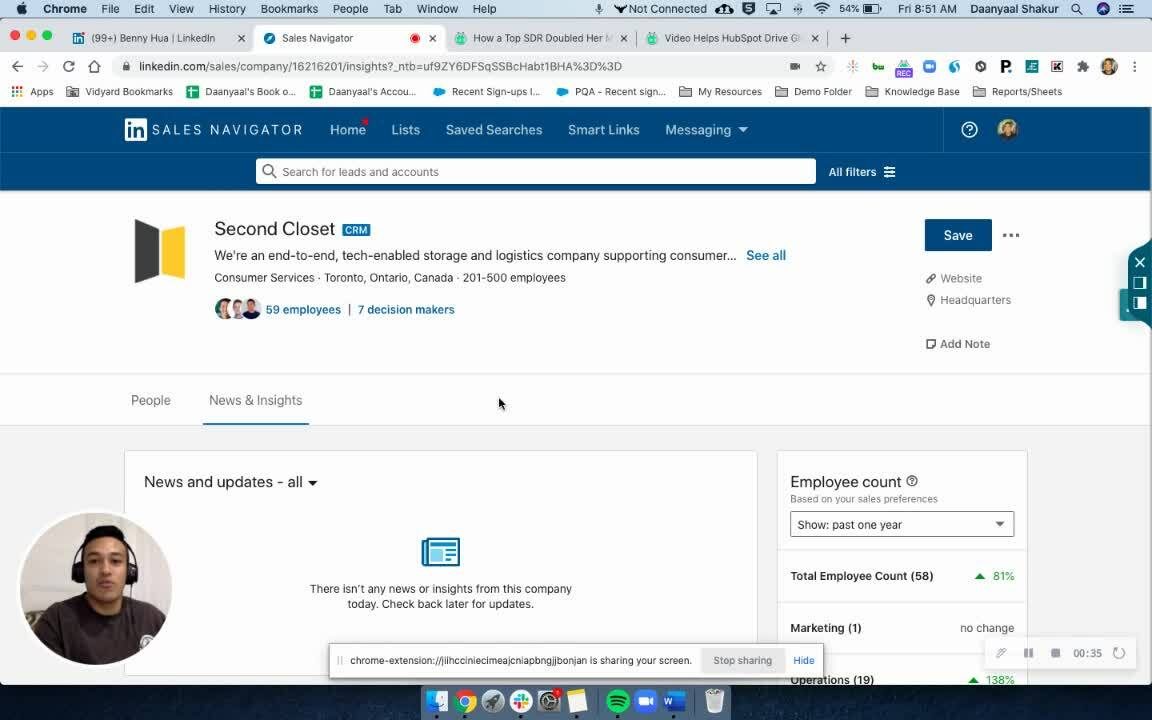From the ubiquitous Zoom calls to the billions of hours of Netflix streamed, 2020 was truly the year of video.
Video usage for sales teams was no exception. Vidyard’s latest research shows a 93% year-over-year increase in the number of businesses using video for sales prospecting and customer engagement.
With the world stuck at home, video became a highly effective tool for connecting with prospects on a personal level and driving more deals. The results speak for themselves: leveraging video across the sales cycle helped Flight Centre Travel Group close $42 million in new business in six months, to name just one example.
Knowing how to use video in your sales cycle is one thing; operationalizing it throughout your entire team is another. My fellow sales leader Morgan Ingram from John Barrows runs a three-day prospecting training, which includes the basics of using video.
But when teams he works with don’t have the internal support to launch their video program properly, it can be a disaster. “Without fail, it takes the reps an hour to record their first video,” says Morgan. “They’ll struggle with what to say, how to say it, and even how to compose the email.”
Many teams are eager to harness the power of video, but fail to give their reps the support and enablement materials they need to succeed. Here’s how to avoid these pitfalls and ensure your team gets the most out of video.
1. Start with an enablement plan
Those of us who have been using video for years can forget just how nerve-wracking it can be for first-timers. Left to their own devices, reps may waste hours laboring over their first video. If they don’t get a response, they’ll be discouraged and won’t use video the next time around. In order for your team to succeed with video, you need to enable them with specific use cases and examples.
Begin by identifying where you want to use video in your sales cycle. Choose three to five use cases to start with (you can always expand these later) for instance:
- First touch
- Discovery call follow-up
- Demo follow-up
- Proposal walkthrough
- Handoff to a CSM
Next, consider what kinds of videos you want your reps to be using. Will they be recording webcam videos? Making screen recordings? Using pre-canned content from product marketing? Be as specific as possible so they know exactly what kind of video they should be using at the different phases you’ve identified. For instance, here’s an example of a first-touch screen-recording video:

Once you know your use cases and video types, start to build a library of examples and implementation ideas to educate your reps and get them comfortable. Record video examples (at least three per use case to give your reps ideas for different approaches).
Write scripts your team can adapt to their own purposes. Share ideas of what they could be showing on their screen, how to position themselves, and so on. And don’t forget about email templates; after all, the content around a video is just as important as the video itself.
Do a walkthrough session where you can demonstrate the whole process from start to finish and answer questions. Then allow them to start playing around with your video tool.
2. Get your team comfortable with video
Repetition is key to video success. Be sure to set usage goals during your initial enablement session. What kinds of videos should your reps be creating? How many should they aim to record per week? Set goals that are achievable, yet challenging enough that they’ll have to practice their video skills frequently, ideally on a daily basis.
Because seeing your own face in a selfie video can be jarring at first, teams should start with screen share videos to get comfortable with recording themselves. In a screen share, your face appears in a corner of the screen, but the main focus is on whatever you happen to be sharing at the moment – whether that’s your prospect’s website, your website, or a sales deck.
As your team gets used to doing screen shares, you can encourage them to start branching out into selfie videos, like this one:

Additionally, encourage your team to use video internally to communicate with their teammates and managers. This is great practice in a low-stakes environment and can help normalize the experience of recording and sending videos.
When your team starts sending out videos to customers for real, have them start with customers you already have good relationships with. They’re more likely to get enthusiastic responses and having that kind of positive feedback early on can do wonders for their video confidence.
3. Track your team’s video adoption
With your team up and running with video, it’s time to measure how you’re doing. If you’re using a video platform, you can track your adoption inside the app or use a sales tool like Outreach.io. However you’re tracking it, make sure you’re monitoring how many videos your reps are sending and what their response rates are. You should also be feeding all this data into your CRM or sales acceleration platform.
On the business side, you need to be tracking your analytics so you understand what kinds of videos are driving deals forward. Think back to your three to five use cases. What kinds of response rates are you getting at first touch, both with and without video? Is there a noticeable difference? Strategically implementing video at key points in your sales cycle, like this meeting follow-up, can help move deals along.

Ideally, you want to be tracking the impact that video has at each phase of your “deal timeline”. What effects are you seeing at each stage? From there, you can refine and optimize your approach. Part of that comes down to giving your reps feedback.
4. Provide feedback and coaching
In order for your reps to get the most out of video, empower them to take ownership of their own success. Make sure that they’re responsible for how many videos they’ve sent. Did they hit the milestones you’re asking them to? What’s the response rate like? What feedback do they have for themselves? Give them opportunities to reflect and fine-tune their process.
Peer feedback is also invaluable. Have your reps review each others’ videos and give each other pointers. You can also create a Slack channel for video wins, allowing your reps to share their best work and learn from each others’ successes. It also encourages them to try out creative new ideas, like this one, where Mike serenades his prospect into booking a meeting with him:

As a manager, you should be reviewing your reps’ videos and giving them regular feedback just like you would their sales calls. This doesn’t have to be complicated. You can do quick “spot checks” by having your reps copy you on the emails they’re sending or schedule some time each week to check their videos in your video platform.
When you give feedback, here’s what to focus on:
- Video thumbnail: Is it engaging? Does it entice the viewer to click?
- Video length: Is it concise and to the point? Different types of videos have different ideal lengths, but as a rule of thumb, shorter is better
- Tone of voice and body language: Does your rep seem warm and friendly?
- Personality: Does the video feel authentic to the person sending it?
Video isn’t a static thing. Just as you’re constantly updating your sales cadences and sequences, you need to continuously optimize your video strategy. Look at your deal cycle from a high level – what areas are you struggling with right now? Where are deals getting stuck?
Work on refining and improving the videos you’re using at those stages – or if you’re not using video, see if adding one would help. Constantly experiment and improve your approach.
Final thoughts
Adding video to your sales process can be an incredibly powerful strategy – enabling you to improve response rates, shorten your sales cycle, and close more deals – but it only works if your team is using it effectively. You need to set them up for success with the right enablement materials, support, measurement, and coaching. With those in place, you’ll be unstoppable.



